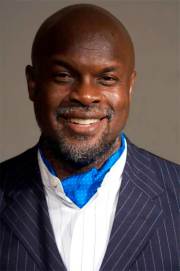 It’s been a whirlwind year of arts-related activities for Tukufu Zuberi, a professor of sociology and Africana studies at Penn and the University’s Lasry Family Professor of Race and Relations.
It’s been a whirlwind year of arts-related activities for Tukufu Zuberi, a professor of sociology and Africana studies at Penn and the University’s Lasry Family Professor of Race and Relations.
First an exhibit he curated for the Independence Seaport Museum opened May 4. Then on June 2, Black Bodies in Propaganda: The Art of the War Poster — an exhibit of wartime propaganda posters that Zuberi both collected and curated — opened at the Penn Museum.
On top of all that — and while hosting the tenth season of PBS’s History Detectives TV show — Zuberi somehow also found time to write, direct and produce the feature-length documentary film African Independence. It won Best Director and Best Documentary at the San Diego Black Film Festival in January.
While we can’t claim to know how Zuberi finds time to sleep, we can give you this overview of his recent arts-and-culture projects:
Tides of Freedom: African Presence on the Delaware River
On view at the Independence Seaport Museum on Penn’s Landing through 2015.
Spanning 300 years of African-American history along the Delaware, Tides of Freedom explores the concept of freedom through the museum’s collection and four major moments in Philadelphia’s history: enslavement, emancipation, Jim Crow and the Civil Rights era. Zuberi himself recorded introductions to each section of the exhibit, which is the first in the Seaport Museum’s new “Freedom” series.
The museum’s recovered “waste book” — a 250-year-old ledger that documents commercial transactions on the wharf — is one of the artifacts on display. Zuberi discovered more than 60 entries of bought and sold African slaves in the book, which is said to be the only document of its kind in Philadelphia.
You can see scans from the “waste book” online here.
Black Bodies in Propaganda: The Art of the War Poster
On view at the Penn Museum through March 2, 2014.
Zuberi combed through his personal collection of propaganda posters to curate Black Bodies in Propaganda at the Penn Museum. The exhibit presents 33 wartime posters, the majority of which target African and African-American civilians. According to the Penn Museum, “these carefully designed works of art were aimed at mobilizing people of color in war efforts, even as they faced oppression and injustice in their homelands. The exhibition explores changing messages on race and politics through propaganda—from the American Civil War, to World War I, World War II, and through to the African independence movements.”
As Zuberi explained: “These posters tell a story about the dynamics of race. Black bodies are racialized in these posters as they capture defining moments in history. Race is always about second-class citizenship, it is always about a relationship between two groups and how one group is defined as superior and the other group is defined as inferior. These posters represent definitive moments in this historical process.”
Zuberi has done several radio interviews about the exhibit that you can listen to online, including:
African Independence
Screening at select events and locations, including Penn’s State of the Field of Africana Studies Conference on Oct. 17, 2013.
Here’s the official synopsis for the 2013 feature-length documentary that Zuberi wrote, directed and produced:
The film highlights the birth, realization, and problems confronted by the movement to win independence in Africa. The story is told by channeling the voices of freedom fighters and leaders who achieved independence, liberty and justice for African people. This film offers a unique presentation designed to enlighten and provide audiences with insights from Africans into the continent’s past, present, and future. Through the lens of four watershed events—World War Two, the end of colonialism, the Cold War, and the era of African Republics—AFRICAN INDEPENDENCE shows a unique side of Africa’s recent history.
This is the trailer:
And here’s an interview Zuberi did about his academic career and making the film:
History Detectives
 Zuberi has been a host for all 10 season of PBS’s History Detectives, the most recent of which aired last June through October. (We’re told that Season 11 is being filmed right now.) He’s one of five “detectives” on the show who each travel the country delving into historical mysteries, local folklore and family legends.
Zuberi has been a host for all 10 season of PBS’s History Detectives, the most recent of which aired last June through October. (We’re told that Season 11 is being filmed right now.) He’s one of five “detectives” on the show who each travel the country delving into historical mysteries, local folklore and family legends.
In this video, Zuberi explains why he enjoys working as a history detective.
You can also watch full episodes from the show’s tenth season here.















